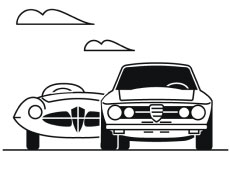-
Insurance
InsuranceAbout our productsLearn about insuringGet a quote Get current values, historical values, model history and more.
-
Valuation
ValuationHagerty valuation toolLook up a vehicle value Get current values, historical values, model history and more.
-
Events
EventsHagerty official eventsHagerty ClubhouseEvent calendar
-
Entertainment
EntertainmentMore to explore
- Portal login
1959 Maserati 3500GT
Spyder Convertible 3.5 L
Vehicle values by condition
Fair
Condition 4
£364,000
#4 cars are daily drivers, with flaws visible to the naked eye. The chrome might have pitting or scratches, the windshield might be chipped.
Good
Condition 3
£474,000
#3 cars could possess some, but not all of the issues of a #4 car, but they will be balanced by other factors such as a fresh paint job or a new, correct interior.
Excellent
Condition 2
£539,000
#2 cars could win a local or regional show. They can be former #1 cars that have been driven or have aged. Seasoned observers will have to look closely for flaws.
Concours
Condition 1
£597,000
#1 vehicles are the best in the world. The visual image is of the best car, unmodified, in the right colours, driving onto the lawn at the finest concours.
Insurance premium for a
1959 Maserati 3500GT Spyder Convertible 3485
valued at £474,000
£1689.18
/ year*
History of the 1957 - 1962 Maserati 3500GT

1957 - 1962 Maserati 3500GT
The Maserati 3500GT was a very important car for its maker. It was the first time that Maserati had gone toe-to-toe with the Scuderia, and away from the lightly disguised road racers it had built before, such as the gorgeous A6G/2000. The new 3500GT undoubtedly looked great, and it soon picked up a useful slice of the supercar market that Ferrari had essentially had to itself until the 35000GT's launch.
Much of what lay under the 3500GT's skin was based on the old A6G—such as the tubular steel chassis, the coil spring independent front suspension, and the live rear axle on semi-elliptic springs. The straight-six engine was a significant step-up, though, developing more power than the A6G, and the 3500GT's power unit was distantly related to the 250F Grand Prix car's as well as the 300S and 350S sports racers. It was up-to-the-minute, boasting a twin-overhead camshaft design that had been reworked by chief engineer Guilio Alfieri to improve power delivery and make it docile enough for road use. It offered three Weber carburettors and two spark plugs per cylinder, and boasted a power output of 220 bhp.
Most of the coupés were made by Touring using aluminium panels and Superleggera principles, but Bertone, Allemano and Frua also produced their own 3500GT variations, while Moretti and Boneschi built one-offs. A Spyder was also produced, styled by Giovanni Michelotti while he was at Vignale. Maserati continuously developed the 3500GT during its life and front disc brakes were introduced in 1959, and the 3500GTi was introduced in 1961. This new Maserati became the first Italian production car to feature fuel injection. Other changes included the introduction of a five-speed manual transmission, disc brakes all round, deletion of the front fog lights, and revised indicators and rear lights.
By 1964, automatic transmission had been introduced, reinforcing the GT status of this beautiful car. The 3500GT enhanced Maserati’s reputation and proved the perfect springboard for it to go chasing sale from Ferrari with a sting of supercars that included the Ghibli and Indy. A final production tally of 2,223 3500GT coupés and convertibles in seven years was an impressive achievement—in specialist car manufacturing terms, this was a serious number of cars in a short space of time.
All 1959 Maserati 3500GT body types
| Year | Make | Model | Submodel | Body Type | Engine size | Average value |
|---|---|---|---|---|---|---|
| 1957 | Maserati | 3500GT | Base | Coupe | 3.5 L | £ 124,000 156,000 181,000 224,000 |
| 1957 | Maserati | 3500GT | Spyder | Convertible | 3.5 L | £ 364,000 474,000 539,000 597,000 |
Hagerty Newsletter
Get your weekly dose of car news from Hagerty UK in your inbox

ADVERTISEMENT